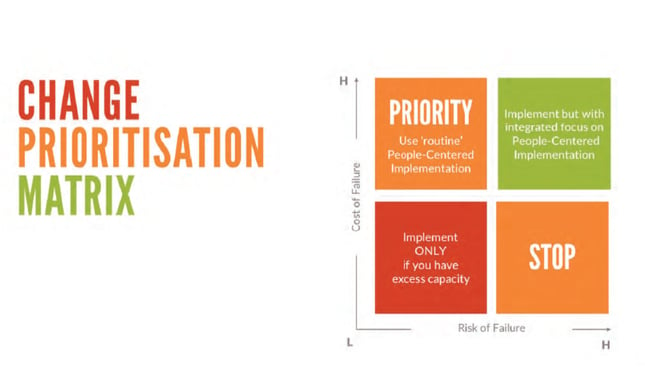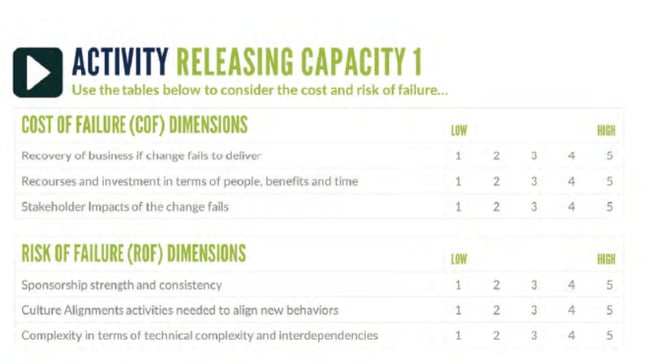
Saying no is often not hard. Saying no to the right things is the challenge that most organizations face. Using a few simple change management tools can help you put in an approach to ensure that your organization accepts the need to deprioritize internal projects, and even become champions of the need to do so.
The importance of saying no
Your organization will most likely have a series of continuous improvement and strategic programs underway at any point in time. Bring in a strategic change program and you naturally bring in even more internal projects that need to be accomplished.
Time and resource poor, it is normal for an organization to feel overwhelmed by the sheer amount of work being asked of it in a time of change.
Individuals, teams and organizations only have a finite capacity for change. In fact, a recent survey shows that almost half of the people asked felt that their organization was already overloaded by change and lacked the focus to get business critical change projects done.

Deprioritizing existing projects provides the capacity needed for strategic change
A key aspect of effective change leadership is providing guidance to your organization on how to say no to work which, although potentially a good idea, is not aligned to your key strategic priorities.
Early planning allows your leadership team to critically review work in progress and determine what works needs to stop to allow the strategic change initiatives to start.
Be clear on how you will say no, and stay consistent
Set up a language and model for how you will classify projects during a deprioritization review.
To help your review team categorize work use a matrix to identify, for each project, what the cost of failure to the organization is, and what the risk of failure is.


Those projects with high risk and low cost should be stopped. Postpone until you have excess capacity those projects which have a low cost and low risk of failure – these are the nice-to-haves.
Continue or start those projects which have a high cost of failure. But treat the high-risk projects with care, your change management approach will need to be carefully considered to help mitigate the risks of implementation.
Use your chosen wording consistently when talking about stopping, starting or postponing projects. Soon it will become part of the natural language of the organization.
Your change vision should help set and align your priorities
Clearly articulate your change vision and business priorities. Use this as a guide for deprioritization and keep the organization focused only on business critical activities.
We encourage all of our clients to first look closely at where their resources time and effort are currently being spent, is it on routine daily tasks, BAU changes or strategic organizational changes?
Simply put, if the project or initiative does not contribute to your stated vision and priorities it should be deprioritized.
Gain early leadership and sponsor buy-in
Aligning your leadership team to the organizational change strategy will be an essential tool to stop those side pet-projects from taking up organizational capacity.
Of course, that is not to say that pet-projects cannot be aligned with the strategic imperatives, but that they also need to be objectively reviewed along with the entire project pipeline.
Inclusion in decision making
Employee inclusion is critical for execution success and a tool to effectively manage the pressures of change in your organization. People are naturally more inclined to see something in a positive light if they have been involved in the planning.
Your employees will also be more understanding of the need to deprioritize parallel work when they are involved in the deprioritization review process. In fact, sometimes your teams are in a better position than the leadership team to identify work that does not contribute to the overall vision.
Review your capacity, risk and return
During the planning stages use your change management tools to determine the capacity required to undertake the project, the effort, duration, risks (especially people risks) dependencies and expected benefits.
Understanding these elements early will provide the information necessary to trade off one initiative against another. Where two initiatives with equally positive and strategically aligned outcomes are competing for resources you will have the information to identify which initiative should be undertaken first.
Mitigate the risk of overwhelming your organization with yet another change initiative
Use simple change management tools to teach your organization to say no to the right things and increase your ability to execute successful change.
Download the article, Article How to Effectively Manage the Pressures of Change, to find out more.


Leave a comment